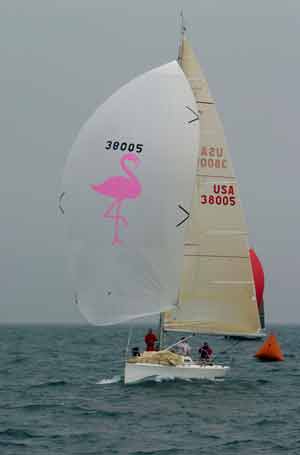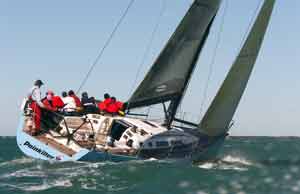
Photo: Boatingshots.com
The “Painkiller Guide to Race-Boat Chartering”
Flamingos and Painkillers (a Pusser’s rum drink) characterize Alice’s sailing program. Flamingos symbolize tropical fun and beauty, but the flamingo is actually a lively and aggressive bird in the wild -for example, doing battle with Eagles in Africa. Painkillers are a nautical drink-made with the rum of the British navy. One of Alice’s crew introduced her to the drink while sailing in the Caribbean and a series of PAINKILLER racing boats resulted. Flamingos on the spinnakers lead the boats into the sea, and painkillers relax the boats’ crews and friends after races and cruises. Plastic lawn flamingos with crews’ signatures are left at yacht clubs around the Great Lakes and in exotic locations such as Antigua, after regattas. Crew shirts and Alice’s hats flaunt the pink bird. Appropriately, one of PAINKILLER’S competitors in Lake Michigan is “Eagle”.
 |
| Alice Martin’s Sydney 38 at the Chicago
NOOD. Photo: Boatingshots.com |
Although PAINKILLER 4, a Sydney 38 racer, was transported for the Key West Race Week in 2000, logistic ease and relative costs have made chartering a favorable option. Chartering also has allowed Alice and her crew to experience different types of sailboats. Alice has owned a Hobie Cat 16, a Pearson Renegade 27, a J-30, a C&C37R (40'), and-at present-a Sydney 38. She occasionally crews on her husband’s Etchells. She has chartered center cockpit cruising boats from the Moorings in the BVI, a Henderson 30 and a Swan 45 (www.onedesigncharter.com) for Key West Race Week, and a Centurion 48 (Sunsail) for Antigua Race Week. She has crewed on chartered boats for several Key West Races with the Windy City Players.
Alice has been racing on Lake Michigan for about 17 years. She has raced her J-30 (Painkiller), the C & C (Painkiller 2) and the Sydney (Painkiller 4) on Lake Michigan and on Lake Huron. (Painkiller 3 is the name reserved for charter boats.) During that time she has placed in several Chicago NOODs, Verve Cups, Ugotta Regatta (Harbor Springs), the Milwaukee Grand Prix, the Chicago and Bayview to Mac Races and the Area III boat of the year series. The crews have mostly been from Chicagoland with a few visitors from Wisconsin, Michigan, Indiana and the East and West coasts. She met her husband Ted when he was crewing on a couple of competitors’ boat.
Keeping competitive with a boat requires a willingness to maintain the boat including the sail inventory. Under the Sydney 38 class rules, she may buy only three sails per year, which keeps some of the costs down. It also forces her to keep track of which sails are used the most and what the condition of the sails is each year. (She buys sails from UK and North.) It also requires her to be careful of what sails she uses on a given day. The sails used on a championship race will not be used on a non-championship race. Staying competitive also requires that she race almost every race, to keep up series scores and stay in practice. The non-championship races give the crew a chance to practice, try out new techniques and for new crew to practice and be observed. The ideal crew size is nine people, including Alice. There are times when the weight limit forces her to sail with eight. Because Alice enters so many races, her crew pool is currently about twenty five. This number allows the boat to race all of the races even though not all of the crew can make all of the races.
Chartering allows racing in venues such as Antigua to which transporting one’s own boat could be prohibitive. Foreign venues expose skippers and crew to new experiences in weather, fleet personalities and social activities accompanying regattas.
When deciding whether to charter or to transport one’s own boat, relative cost is a factor, but logistical ease is another major factor. For the 2005 Key West Race Week, for example, the transport cost for the Sydney 38 was high due to increased fuel costs, and the keel would have to be removed for transport and reassembled at both ends of the transport and back, adding to the cost (labor and fiber glassing). Storage must also be located and weather conditions may affect optimum transport dates, e.g. going south, attempts are made to avoid hurricane season. When choosing a transport or a charter company, references are valuable to assess experience and reliability, and suggestions are frequently included within regatta notices.
The charter company will generally not take care of housing, crew organization, food and social events, although it can be helpful in providing contact information and suggestions. The contract should be carefully scrutinized and at least should include a detailed description of equipment (safety, navigation) and sail inventory, specifically what costs and services are covered in the charter, insurance coverage, provisions for damage costs not covered by insurance, adjustments for failure of the boat or of the charterer, emergency provisions and responsibilities, inspection procedures at the beginning and end of the charter, and provisions for dispute resolutions.
Choice of a boat to charter depends on your goals and theme. Do you just want to have fun? Then a comfortable boat in a handicap racing section may be best. If you want to really match and improve your sailing skills by racing against some of the best, one design sections are perhaps a more natural choice. If opting for a one design boat, be sure to check class rules and also investigate the “personality” of the class to determine if that is with what you are comfortable. Some classes have provisions for pros as crew, others do not. Some classes are more concerned about the competition level than the social aspects. Also choose a boat for which you can recruit the kind of crew you want.
The charter company for the Swan 45, provided delivery to Key West, dockage, bottom cleaning, appropriate equipment, local knowledge, a captain experienced on the chartered boat, and assistance in executing the charter contract. These conveniences for us outweighed the cost difference, which was not large enough to warrant transporting the Sydney 38. How much do you want to spend? Is the crew contributing toward costs?
 |
| Alice Martin’s Swan 45 Painkiller
racing down in the Key West. Photo: Boatingshots.com |
Half of the crew for Painkiller 3 at KWRW this year was from the Midwest and the Chicagoland area. The only Painkiller 4 crew making the KWRW pilgrimage this year were Alice (helm), her husband Ted Jones (downwind trim) and Cliff Black (jib trim). Cliff and Ted are both US Sailing judges. Other Chicago-based sailors joining them included, Mike Panacek (pit), Patrick Haywood (foredeck) and Tim LaButte (pit). Tim lives in Toronto.
The remainder of the crew included three sailors from Annapolis, John Sweeny (mast), Bob Taylor (jib trim) who was the charter broker (www.onedesigncharter.com) and Dobbs Davis (main trim) who is a professional sailor, coach, international match racer, match race umpire and US editor of SeaHorse magazine. The other pros were Don Kelly (foredeck) from New York (the owner’s representative, who in addition to performing as the foredeck, also maintained and delivered the boat) and finally Chris Law (tactician) from England. Chris is a match racer on an international level. He has won Swedish Match Cup, the Etchells Worlds, medaled in the Olympics, raced in the America’s Cup and raced most every type of boat for about 40 years.
Dobbs helped Alice put the KWRW program together. He also introduced Alice to Chris. Without Dobbs and Chris, the boat and crew would not have performed nearly as well. Chris, Dobbs and Don were constantly working on the mast tune and sail trim. Chris put Alice in most of the right places on the course. During the practice days, Dobbs and Chris put the crew through very rigorous training in how to handle a Swan 45. Alice and the crew were used to sailing with professionals but, because of the level of racing in the Swan 45 Class, Chris and Dobbs had to be demanding in the level of performance of each crew member.
With the collective crew experience on Sydney 38’s, Farr 40’s, Etchells, Santa Cruz 70’s, J 29’s, Shock 35’s, etc., getting familiar with the Swan 45 in two practice days in twenty five to thirty knots of wind was difficult. For the Swan, there are two bowmen and two people were in the pit where most of the boats the crew have sailed on have one person. The boat is very powerful and all of the parts tend to carry a lot of load, making for a tired crew at the end of each day. In fact despite all the partying that takes place during KWRW a lot of the crew found themselves heading to bed before 10 pm. The Swan is very well built and Nautor obviously put a lot of effort into making the boats very equal in speed. Even after 12 miles of racing, boats were crossing tacks at the finish line. One time Alice’s crew put a substantial lead (about 20 boat lengths at the finish) on the other boats was when the wind went light, about 4 to 7 knots true wind speed. All of a sudden the conditions, which had been in the 20’s and high 30’s, started to look a lot like sailing in Chicago in the summer. Light, streaky and 30°+ shifts. Alice was very good at keeping the boat moving and Chris did an excellent job of following the dying breeze.
For KWRW 2005, Painkiller 3 won a daily trophy and placed many times. However, a first and a second place finish were lost in the protest room despite having experienced judges on the crew, and with a couple of DSQs, the Painkiller 3 crew could only look back at what might have been an overall win.
Racing rules must be well known so protest rooms can be avoided or-if inevitable, will be satisfactorily resolved. If your chartered boat is part of a section where you are the outsider, anticipate that your boat may be a target for protests, and as Alice found out, you might want to consider making adjustments to your strategy and tactics to avoid potentially problematic and damaging encounters. If you are in a section where all boats are chartered, this is less of a problem.
Chartering can provide wonderful experiences for you and your regular crew, and introduce you to new crew and fellow sailors. Your racing and/or sailing skills can improve. You may expand your horizons e.g. there are other good rum drinks besides Painkillers! But successful charters require planning and flexibility. Despite planning-there will be surprises-good and bad!
Next year, the Swan 45 Worlds will be sailed at KWRW. Alice is
thinking about it, hard.
Alice Martin is a partner in the law firm of Barnes & Thornburg specializing
in Intellectual Property Law. She lives in Chicago, IL.